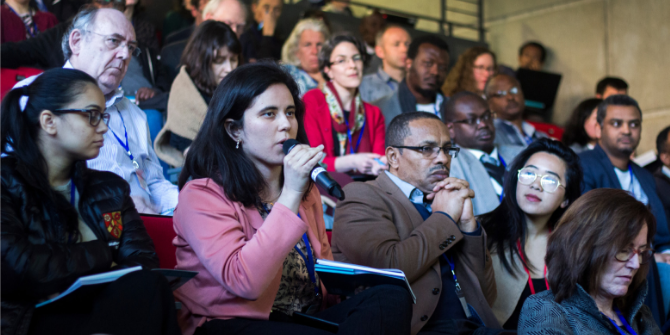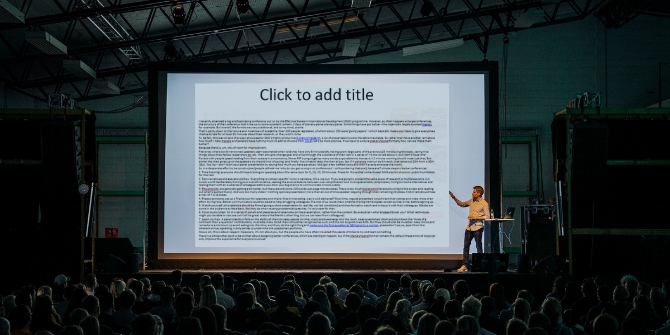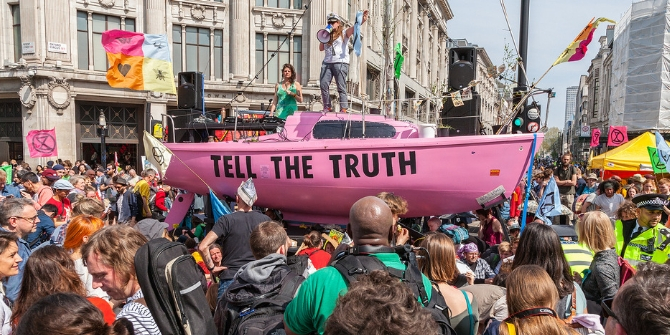The COVID-19 pandemic has led to an intense period of innovation in how academic events are mediated and communicated to online audiences. As in-person academic events begin again, Mark Carrigan, considers whether we are returning to an implicit new normal in which hybrid in-person events are the default mode of communication. Whilst this format may prove useful, he argues that the environmental and accessibility benefits of online and a-synchronous forms of communication should not be jettisoned in the urge to resume business as usual.
I suspect I’m not alone in feeling startled to receive invitations to face-to-face events. In many cases these are hybrid events, with smaller physical meetings being broadcast through the internet in a manner which potentially combines the best of both worlds. It remains to be seen whether this potential can be lived up to, particularly given the increased costs associated with these formats until the infrastructure for them becomes the norm within universities. There are circumstances in which hybrid events will be the right choice, if for instance there’s a critical mass of participants within a local area alongside a distributed audience of significant size. If there’s adequate infrastructure, then hybrid events can provide a valuable means for distributed audiences to listen in to face-to-face meetings.
The equipment and expertise which are currently necessary to run a hybrid event mean it probably isn’t the right (or sustainable) choice for a relatively niche event that is unlikely to attract much of an online audience.
The equipment and expertise which are currently necessary to run a hybrid event mean it probably isn’t the right (or sustainable) choice for a relatively niche event that is unlikely to attract much of an online audience. In which case it might make more sense to have a physical event, with a collective output which can be distributed asynchronously. Digital artefacts like blogposts and podcasts have a tendency to circulate far beyond their original creators. The raw fact of access can be valuable, but the careful packaging of ideas and discussions can be a much more effective way of facilitating remote participation. It might be that only a small number of people would tune in synchronously to engage with an event, but a digital output from that event over time might assemble a significantly larger audience. If the potential speakers at the event are similarly dispersed, it means that bringing them together will involve funding. The trains, planes and hotels involved in facilitating a typical academic gathering have more or less fixed costs, even if they don’t show up on the budget of the event organisers.
I have been organising face-to-face events for almost twenty years. For significant periods of my academic life I’ve organised seminars, workshops and conferences on an almost monthly basis. I miss coordinating such events and I miss attending them. However, I’m sceptical of the turn towards hybrid events because the conditions in which this is an effective medium remain relatively rare.
Furthermore, I’m cautious that hybrid events offer a return to something which feels like normality, despite things still being far from normal. My concern is that this seeming promise is getting in the way of a deeper engagement with the questions which the pandemic has raised about how and (more importantly) why we organise workshops, seminars and conferences. In spite of the unrelenting grimness of the last eighteen months, a disruption of this magnitude provides us with an opportunity to re-evaluate previously taken for granted features of how we organise academic interaction.
My concern is that this seeming promise is getting in the way of a deeper engagement with the questions which the pandemic has raised about how and (more importantly) why we organise workshops, seminars and conferences.
If we want to return to face-to-face events we need to grapple with their deficiencies. These were not equal or accessible spaces. They were often costly to attend, with those most in need of financial support the least likely to be able to access it. They encouraged a jet-setting culture that is simply incompatible with a recognition of the climate crisis. Reform was already underway, driven by widespread concerns about environmental impact and accessibility. There are questions concerning environmental impact, accessibility and the reproduction of academic hierarchies that received much wider attention during the unprecedented disruption of the early pandemic and now risk receding into the background. There are serious reasons to be cautious about a return to face-to-face events, many of which precede the disruption of the pandemic. I would argue it remains at present a bad idea to encourage large numbers of people to gather together indoors for sustained periods of time during a pandemic which is very much ongoing. However, the point I’m making here isn’t about the epidemiological risk, but rather the widespread assumption that we should return to our old patterns of face-to-face meetings as soon as the circumstances allow for it.
This isn’t an argument against physical meetings, but rather a plea that we avoid drifting back to them. The familiar rhythms of seminars and conferences feel intensely alluring after the isolation and suffering which have characterised the last eighteen months. However, do we really want to return to a situation where they are the default? Or could we imagine an approach to academic events which recognises how these options (face-to-face, hybrid, digital) are equally worthwhile depending on what we’re trying to achieve? We’ve barely scratched the surface of how we could innovate with online conferences and there’s no reason they need to feel like poor substitutes. My fear is that the potential to build a more resilient, equitable and sustainable social infrastructure for scholarship will be wasted if we rush back to our old ways of doing things.
Note: This article gives the views of the author, and not the position of the LSE Impact Blog, nor of the London School of Economics. Please review our comments policy if you have any concerns on posting a comment below
Image Credit: Adapted from Dom Fou via Unsplash.









In 1992, The Education Faculty of Deakin University hosted the annual Australian Association for Research in Education conference. Bill Green and I decided, rather foolishly, to run an electronic salon in parallel with the conference. We were able to assemble a dozen or so excellent papers from key thinkers around the world and established an email list to support discussions. It was probably the first of its kind in education. It worked well for the overseas participants but was less attractive for those who attended the conference. During the conference the then Federal Minister for Education came to open the new Education building. Deakin’s public relations office asked me to “show” the Minister the e-salon! I produced a summary list of external participants by country and arranged for him to write an email to the list. I discovered later that he thought the e-salon was a hoax. What followed was amusing and informative. The Minister’s email prompted a flurry of replies addressed back to him from people not only in his electorate but from around the world. These were ‘tidied’ and forwarded to his office, at which point he apparently conceded that the e-salon had taken place.